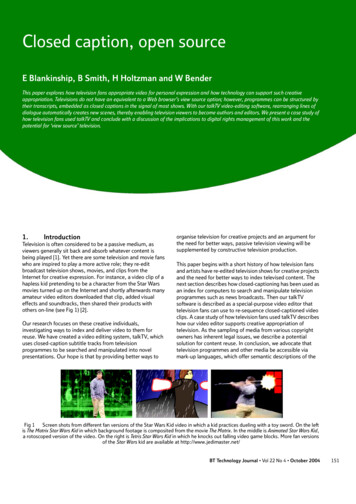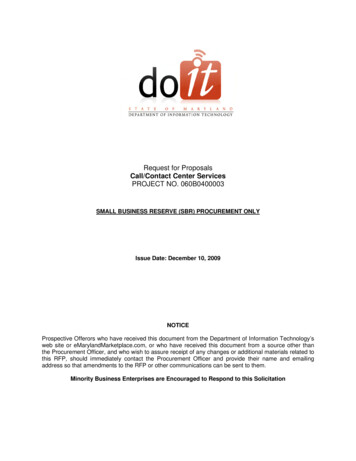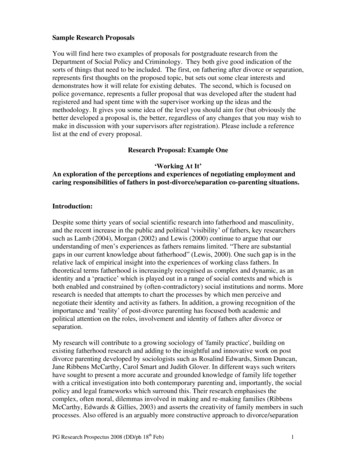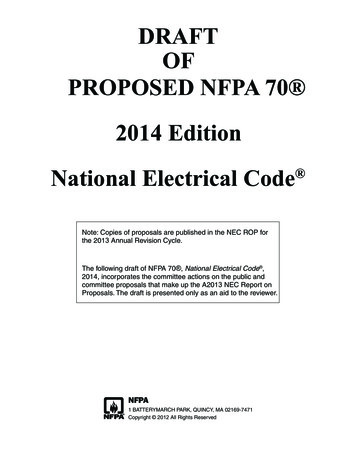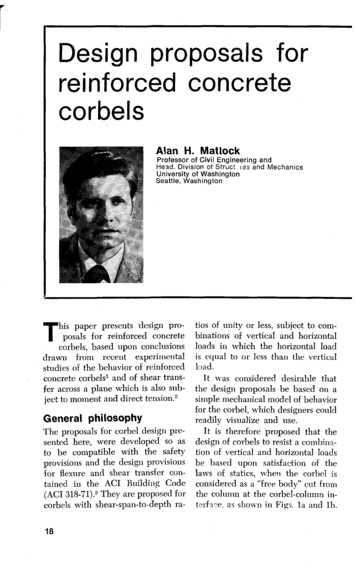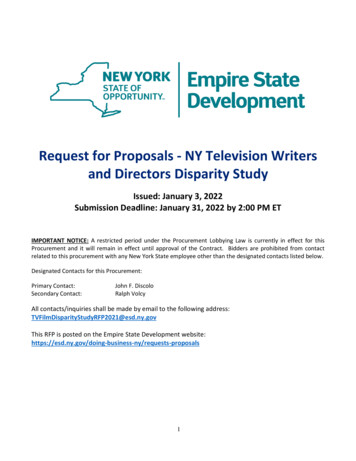
Transcription
Request for Proposals - NY Television Writersand Directors Disparity StudyIssued: January 3, 2022Submission Deadline: January 31, 2022 by 2:00 PM ETIMPORTANT NOTICE: A restricted period under the Procurement Lobbying Law is currently in effect for thisProcurement and it will remain in effect until approval of the Contract. Bidders are prohibited from contactrelated to this procurement with any New York State employee other than the designated contacts listed below.Designated Contacts for this Procurement:Primary Contact:Secondary Contact:John F. DiscoloRalph VolcyAll contacts/inquiries shall be made by email to the following address:TVFilmDisparityStudyRFP2021@esd.ny.govThis RFP is posted on the Empire State Development sts-proposals1
SECTION I – PURPOSE, BACKGROUND & SCOPE OF SERVICES1.0PURPOSENew York State Urban Development Corporation, D/B/A Empire State Development (“ESD”), on behalfof the State of New York (“NYS” or “State”), is authorized and required by statute, to seek the servicesof a qualified vendor (“hereinafter Respondent”) to design and conduct a complete, comprehensive andlegally supportable statewide disparity study (“[YEAR] Disparity Study” or “Study”) regarding the State’suse of tax credits to encourage employment, usage and/or retention of minorities and women as writersand directors in the NYS television industry.Disparity Studies are the primary means by which States and large municipalities determine whetherthere is legal justification for the establishment, continuation or modification of race and gender basedprograms designed to remedy identified disparities in a given industry. The Study must provide the basisfor determining whether a remedial program of awarding a State tax credit on the basis of race/genderis supported by law, and the extent to which it may be implemented as a remedial measure meant toreduce disparities in the participation by minorities and women as writers and directors in the televisionindustry in NYS. The study must also establish the basis by which to evaluate the impact of the use oftax credits to lower the costs to relevant television production companies in hiring more minorities andwomen as writers and directors as defined under the statute and alleviate identified disparities.For the purpose of these objectives, the selected Respondent shall be guided in its work by theparameters set forth by the United States Supreme Court in the cases of City of Richmond v. J.A. CrosonCo., 488 U.S. 469 (1989) (Croson), and Adarand Constructors, Inc. v. Pena, 515 U.S. 200 (1995) (Adarand)and their progeny as well as any other applicable law that bear on the rights and abilities of stategovernments to implement race and gender conscious preference programs. The Disparity Study isexpected to investigate and where applicable, identify discrimination in the relevant industry, in order tosupport a race and gender conscious program to ameliorate such discrimination. Such findings, whichshould be robust and defensible and may include both statistical and anecdotal data, provide the State a“compelling interest” in offering tax credits in the NYS television industry for the utilization of minorityand women writers and directors. Importantly, the continuing success of the State’s remedial programsrequires that they not only be carefully justified, but also meticulously applied such that preferentialtreatment based on race and gender is determinative in only those very narrow circumstances in whichit is truly relevant. To that end, the Respondent should reference and be conversant with all relevant NYSand federal laws relating to industry participation on the basis of race and gender.1.1B ACKG ROUN DIn 2019 the television writers' and directors' fees and salaries credit legislation was passed by theLegislature and signed by the Governor on the condition that, in order to meet constitutional muster,there would be a chapter amendment to the bill requiring a disparity study to first be conducted todemonstrate any potential underutilization of minority and women directors and screenwriters in thetelevision industry who would benefit from this legislation. As set forth in Part XX, Subpart X of Chapter55 of the Laws of 2020, implementation of this credit is conditioned on a finding of such underutilization.2
1.2 DEFINITIONSThe following are definitions related to this RFP.Minority group member shall mean a United States citizen or permanent resident alien who is and candemonstrate membership in one of the following groups: Black persons having origins in any of the Black African racial groups;Hispanic persons of Mexican, Puerto Rican, Dominican, Cuban, Central or South American of eitherIndian or Hispanic origin, regardless of race;Native American or Alaskan native persons having origins in any of the original peoples of NorthAmerica.Asian and Pacific Islander persons having origins in any of the Far East countries, South East Asia,the Indian subcontinent or the Pacific Islands.Writer means a person who is engaged by a qualified film production company or a qualified independent filmproduction company to write television scripts, outlines, rewrites, stories, or teleplays for television series andwho reports to work regularly in a writers room located in the State. For the purposes of this definition, "writer"shall not include showrunners or executive producers.Writers room means a room or physical location in the state where writers employed by a qualified filmproduction company or qualified independent film production company write television scripts, outlines,rewrites, stories, or teleplays for television series utilized in a qualified film. A writers room is located in thestate only if it is in use in the state at least eighty percent of the time it is in existence.Director means an individual employed or retained to direct the production, as the word "direct" is commonlyused in the motion picture industry, who would be classified as a director under the basic agreement in placebetween the Association of Motion Picture and Television Producers and the Director's Guild of America andwho must meet the minimum criteria for work on qualified productions in New York state as established by thecommissioner of economic development by regulation.Qualified film production company shall mean a corporation, partnership, limited partnership, or other entity orindividual whose project is conditionally eligible to receive a tax credit under section twenty-four of New YorkState Tax Law which or who is principally engaged in the production of a qualified film and controls the qualifiedfilm during productionQualified film means a television film, television pilot and/or each episode of a television series, regardless ofthe medium by means of which the film, pilot or episode is created or conveyed.1.3 SCOPE OF SERVICESThe State is seeking a qualified Respondent to design and conduct a statewide disparity study and policyreview, and if supported by the Respondent’s results, would provide the basis for the use of tax credits on feesor salaries as a remedial measure to alleviate any such identified disparities:1. Workforce Study3
For the Workforce Study, the Respondent shall design and conduct a study to assess the level ofemployment of qualified minorities and women as directors and writers on NYS television productions,and specifically on productions participating in the NYS Film Tax Incentive Program. In so doing theRespondent shall assess level of disparity of women and minority writers and directors based on theiravailability and employment within New York State’s television industry, and where appropriate as definedby law.2. Policy ReviewThe Respondent will conduct a review of best practices, along race and gender conscious remedialprogrammatic tools in other states and large municipalities that may be relevant to the NYS context.Respondent must also provide a literature review of the impact of the use of financial incentives (such astax credits by states and large municipalities) to lower the hiring costs to relevant television productioncompanies in hiring more minorities and women as writers and directors as defined under the statute. TheRespondent shall also provide an analytical methodology with data and recommendations to assist ESD indetermining on an annual basis the impact of the Writer and Director Diversity Credit on the hiring ofminorities and women to these targeted positions.A. Data CollectionThe Respondent shall be solely responsible for defining, researching, compiling, and analyzing all datarequired to provide the services described in this RFP. The State will, to the extent possible, makerecords available to the Respondent and cooperate with the Respondent in the retrieval of the recordsfrom third parties to the extent reasonable and practicable. The records may be available in variousformats including the Internet, computer databases, spreadsheets, and physical copies. Where ESDdoes not provide the Respondent with data, the Respondent must research and gather such data, andmust set forth the methods and sources by and from which the data was collected and the steps takento ensure data integrity. The Respondent may use statistically valid sampling and estimating methods,as appropriate, where actual procurement data and records are incomplete. However, the Respondentis responsible for the legal sufficiency of any such method used.1. NYS Television Data from NYSAt its discretion and as available ESD will provide the Respondent with relevant data in its review andapproval any request for available and releasable state or other relevant governmental data.2. Availability Industry DataThe Respondent shall research the existence of women and minority directors and writers within theState’s relevant television production market area as a whole and, as appropriate and agreed by ESD,within the various regions of the State. In addition the Respondent shall research, review, and include,as appropriate, information from public and private registries of directors, business or industry groups,listings of nationally and locally recognized industry organizations, and as appropriate the New York4
Department of State database of active television production related companies, etc. Furthermore, theRespondent shall also obtain and analyze relevant data sources, such as U.S. census data, and shalldemonstrate that it has employed valid statistical sampling in order to accurately ascertain the numberof women and minorities in the State’s relevant market area.3. Workforce Availability DataThe Respondent shall research the existence of qualified minorities and women within the State’srelevant market area as a whole, and as appropriate, within the various regions of the State. TheRespondent shall research, review, and include as appropriate information from sources including, butnot limited to the New York State Department of Labor, workforce or industry groups, federal and localworkforce data, etc. Furthermore, the Respondent shall obtain and analyze relevant data sources, suchas U.S. Census data, and shall demonstrate that it has employed valid statistical sampling to accuratelyascertain the number of minorities and women in the State’s relevant television market area.B. Disparity AnalysisIn determining whether any disparity exists for the Study, Respondent shall (i) define and calculate availabilityof minority and women writers and directors in NYS; (ii) calculate the make-up of women and minorities ontax credit eligible television productions within NYS; And; (iii) conduct appropriate statistical or econometricanalysis of employment utilization data to determine the extent, if any, there are disparities in workforceutilization.1. Availabilitya. Workforce StudyThe Respondent shall define, quantify and explain the availability of qualified minority group members andwomen in the relevant television industry market sectors, subsectors (by NAICS codes and other reverentindices) and if and as appropriate, regions of the State for writers and directors. The analysis of minoritiesand women in the television industry should include breakdowns by race and gender. In analyzingavailability, the Respondent shall:i.Determine and report on the criteria used to define qualified and available minority group membersand women as writers and directors within the television industry and by regions of the State;ii.Collect and provide data on minority group members and women, if and as appropriate by regionand market sector that includes an assessment of information pertaining to business and professionalcapacity to perform on television industry production contracts as directors and writers, brokendown by gender and minority group member status on such television industry productions andcontracts. Workforce data shall include information impacting workers’ ability to perform on5
television industry contracts and productions including, where appropriate, skill and training levels,experience, education and union and industry affiliations, and mentorships; andiii.Collect any other relevant data, based on Respondent’s design of the study2. Utilization of Minorities and Women as Writers and Directorsa. Workforce StudyThe Respondent shall analyze the Workforce Utilization. Relative to television industry productions, theutilization analysis must describe the percentages ofi.The available number of women and minority writers and directors; andii.Women and minorities (as writers or directors) that were actually utilized on NYS televisionproductions and specifically those participating in the NYS Film and TV Tax Incentive Program;iii.Total director and writer jobs awarded to women and minorities within the NYS televisionindustry broken down by subcategories within the NAICS code or other relevant televisionindustry classification for such writers and directors.3. Disparitya. Workforce StudyIn determining whether any disparity exists between the number of qualified minorities and womenthat are ready, willing and able (i.e. available) to perform on state tax credit subsidized NYS televisionindustry productions, and the number of such minorities and women actually engaged to perform suchcontracts and productions– and to the extent possible, subcontracts – the Respondent shall (a) defineand calculate the availability of minorities and women writers and directors; (b) where appropriatesegment the utilization analysis by region and by dollar amount of television industry contract,production staffing size or other appropriate metrics; and (c) conduct appropriate statistical oreconometric analysis of the availability and utilization data to determine the extent, if any, of thedisparity.The Respondent shall also provide relevant anecdotal data and information that accurately sets outthe scope and impact of any relevant disparity identified by the study conducted hereunder.Respondent shall fully define “statistically significant disparity” for the purposes of its analysis, and explainthe rationale underlying its definition. In asses The sing any statistical disparity in utilization rates, theRespondent shall employ appropriate statistical methodologies to control for any relevant non-gender andminority-related characteristics or criteria that might affect the disparity analysis, explain any such criteria itconsiders, and describe the statistical analysis it utilizes.Policy Study Components6
1. Policy ReviewTo the extent applicable based on the results of the disparity study, ESD also seeks an analyticalmethodology with related data and recommendations to assist in determining on an annual basis theimpact of the television writers’ and directors’ fees and salaries tax credit on employment and theeconomy of the State, including with respect to whether the maximum aggregate amount of the creditshould be modified or reduced in order to remain appropriately tailored to any identified disparities inthe utilization of minority and women screenwriters and directors in NYS television industry contractsand productions.ESD further seeks information outlining the use and efficacy of race and gender conscious remedialprogrammatic tools in other states and large municipalities which might be instructive to NY Statepractitioners and policymakers as they craft policies, programs and procedures designed to remedyutilization disparities in State contracting. Croson and similar controlling statutes and their progenyshould guide Respondent’s assessment of such programs.In addition, in the event the study or report produced under this agreement becomes the subject of litigationor other adversarial legal proceedings, Respondent agrees to provide consulting services on such proceedingspursuant to mutually agreed upon terms.1.4DELIVERABLESA. General RequirementsAll deliverables shall be subject to the following requirements:1. The Respondent will be required to prepare and submit the documents, identified below, to ESD as botha physical copy and in an encrypted electronic format compatible with Microsoft software with completetabular findings. ESD shall have access upon request to all data, information, and analyses generatedduring the course of the Study. At the conclusion of the study and delivery of the final report, theRespondent shall also produce in electronic format a copy of all of the data and documents that wereconsidered during the disparity study and in the preparation and completion of the final report.2. All reports shall be: (a) written in clear and concise language using consistent terms; (b) organized in alogical manner; (c) fully illustrated with relevant examples; and (d) consistent with widely accepted andlegally defensible methodology. The Respondent shall provide to ESD all notes, work papers, recordsand documentation that detail, chronicle, and support its methods, analysis and conclusions for eachof the elements in the work. Should the Respondent develop a computerized database in the course ofthe work, the Respondent shall provide the database to ESD. Programs and data entry materialsdeveloped in connection with the Study must be compatible with Microsoft compatible software. Thefinal version of any deliverable must address any deficiencies or concerns raised by ESD regarding thedraft deliverable.B. Monthly Progress Reports7
ESD requires monthly progress reports that describe tasks undertaken and the portion of each task thathas been completed to date, as well as the tasks scheduled to be undertaken in the following month. Thesereports should also identify any problems encountered that might impact the work schedule or thesuccessful completion of tasks, and the steps taken by the Respondent to resolve those problems. Anyrevisions to the work plan must be included in these monthly progress reports.C. Disparity Study Report1. Workforce Study Componenta. Workforce Component of the Disparity Study Report shall address each of the requirements ofSection 1.3 above. This shall include:i.ii.iii.iv.Data CollectionAvailability StudyUtilization AnalysisStatistical Disparityb. Respondent shall provide data on the number of qualified minority group members and women that areready, willing and able (i.e. available) to provide labor as writers and directors on NY State tax creditsubsidized television contracts and productions, and the number of such minority group members andwomen actually engaged to perform on such contracts and productions, and to the extent possible,subcontracts. The data shall, where appropriate, also include dollar value paid for writing and directingon each contract or productions type during the Study period along with the size of the productionbased on budget and region of the State. The data must be organized by industry using NAICS codes,SOC (Standard Occupational Classification), established television industry labor classification identifiersand other relevant factors, such as education level, experience, region of the State, etc. that will enablethe State to ascertain the degree to which a disparity exists between those minorities and womenwithin the relevant marketplace that are ready, willing and able to perform work on State tax creditsubsidized television productions as compared with those minorities and women that are actuallyproviding labor on such contracts and productions.D. Policy Findings1. Policy AnalysisThe policy review shall also provide information concerning policy recommendations basedon Respondent’s understanding of effective tools designed to remediate disparities inminorities and women participation as directors and writers on NY State television industrycontracts and productions. This assessment should include recommended best practicesinformation around legality of policies, such as project goals, set-asides, mentor-protégéprograms, and salary ranges.2. Recommendations to assess impact8
To the extent applicable based on the results of the disparity study, ESD also seeks ananalytical methodology with related data and recommendations to assist in determining onan annual basis the impact of the television writers’ and directors’ fees and salaries tax crediton employment and the economy of the State, including with respect to whether themaximum aggregate amount of the credit should be modified or reduced in order to remainappropriately tailored to any identified disparities in the utilization of minority and womenscreenwriters and directors in NYS television industry contracts and productions.E. Schedule of DeliverablesDeliverable NameDraft Disparity Study ReportFinal Disparity Study ReportDraft Policy AnalysisFinal Policy Analysis1.5Date DueNo later than August 1, 2022No later than September 19, 2022No later than August 1, 2022No later than September 19, 2022MINIMUM QUALIFICATION REQUIREMENTSResponses to this RFP must include information about Respondent’s current capabilities, past experiencesworking with other states and large municipalities and how those experiences may inform or impact workwith New York State as it relates to operating models and leading practices.A. Prior to the proposal due date for this RFP, the Respondent must have been in business for aminimum of five (5) years, performing relevant quantitative analyses, such as those described inSection 1.3 (Scope of Services) of this RFP.B. The Respondent must provide the names and addresses of at least three (3) business references.C. Prospective Respondents must possess adequate financial resources and organizational capacity toperform the services described in this RFP in an efficient and effective manner, with financialresources to pay expenses in advance of receipt of payment from ESD. ESD prefers a letter from aCertified Public Accountant (CPA) indicating that the Respondent has sufficient working capital,positive net worth, and has or can obtain a line of credit. ESD will also accept a letter from a partyother than a CPA (such as an attorney, bank officer, corporate attorney, parent holding company)familiar with and attesting to the financial condition of the Respondent.D. The Respondent must adopt strict privacy protections to adequately protect the confidentiality ofall data. All data transmissions must be encrypted. Throughout the course of this project, theRespondent may have access to confidential company information. The Respondent selected forthis project must agree to protect confidential information and to sign non-disclosure agreementsprepared by ESD. All information provided to, collected or otherwise obtained by the Respondent,the Respondent’s staff and all subcontractors is proprietary and may not be disclosed in perpetuity,to any party other than ESD itself without ESD’s express written approval.E. This section (1.5) of the RFP is not intended to itemize all requirements for an award of this project.9
SECTION II - ADMINISTRATIVE INFORMATION2.0INQUIRIESQuestions or requests for clarification regarding the RFP should be submitted via email, citing the RFP page andsection in accordance with the (Schedule of Dates) to TVFilmDisparityStudyRFP2021@esd.ny.gov. Questionswill not be accepted orally and any question received after the deadline may not be answered. The comprehensivelist of questions/requests for clarifications and the official responses will be posted with this RFP.2.1DESIGNATED CONTACTSFor the purpose of the Procurement Lobbying requirements of this RFP, ESD’s designated contacts arelisted on the front covering page.2.2SCHEDULE OF PERTINENT DATESIt is anticipated that a contract will be awarded in response to this RFP based on the following schedule:Release of RFPDeadline for Receipt of QuestionsDeadline for ESD to Respond to QuestionsSubmission of ProposalsOral Presentations/InterviewsAward of ContractStart of ContractJanuary 3, 2022January 12, 2022January 19, 2022January 31, 2022 by 2:00 PM ETBy appointment at the discretion of ESDTo Be DeterminedTo Be DeterminedInterviews/oral presentations by finalist Respondents may be held at the discretion of ESD.Please note, the Corporation reserves the right to change any of the dates stated in this RFP.2.3SUBMISSION OF PROPOSALSEvery respondent to this RFP (“Bidder”) should submit a proposal which clearly and concisely provides all of theinformation requested. Emphasis should be concentrated on conformance to the RFP instructions andrequirements, as well as completeness and clarity in its proposal response. The Bidder is advised to thoroughlyread and follow all instructions contained in this RFP. Proposals that do not comply with these instructions or donot meet the full intent of all the requirements of this RFP may be subject to scoring reductions during theevaluation process or may be deemed non-responsive.i.Technical ProposalThe purpose of the Technical Proposal is to provide firms with an opportunity to demonstrate theirqualifications, competencies, and capacity to undertake the engagement described herein. Below is alisting of the technical information to be provided by the Respondent. The Technical Proposal shouldcontain sufficient information to assure ESD of its completeness.10
Below is a listing of the technical information to be provided by the Bidder. No information is required beyondwhat is specifically requested. The Corporation requests that all Technical Proposals be in the following order asset forth below:A.B.C.D.E.F.G.Table of ContentsFirm Experience and QualificationsStaff Experience and QualificationsProject Plan and ApproachFirm ReferencesEstimated CostDiversity PracticesA. Table of ContentsB. Firm Experience and QualificationsIn this section of the Technical Proposal, Respondents should demonstrate relevant experience by providingthe following:1. A summary of the Respondent’s technical expertise that describes the unique capabilities of theRespondent. This narrative should highlight the Respondent’s ability to provide successful prior experienceconducting disparity analyses, or analogous studies and include a description of the direct prior experienceof your firm with New York State and/or other comparable governmental entities relating to disparity andpolicy analysis.2. Respondents should detail at least three similar engagements comparable to those services detailed inSection 2.3, but no more than five. Please indicate, for each engagement completed: Name of client organization Type of client (e.g. government entity (local, State, Federal), private company etc.) Project description and services provided Project duration including start/end dates Number of Respondent staff (FTEs) involved in the engagement Any other information regarding the project that would assist ESD in determining the successexperienced by the client. This may include previous disparity studies. If you wish to includeprevious studies as examples of your experience, please include a link to the study and not ahard copy in your proposal.C. Staff Experience and QualificationsIn this section of the Technical Proposal, Respondents should demonstrate that the staff proposed havethe knowledge and ability to perform the services described in the RFP and provide the following:1. A project management and staffing plan that describes the unique capabilities of the individuals assigned.Include a narrative description of the specific function/role that each staff member would perform andtheir specific qualifications for their proposed role in this engagement. Lead staff should be identified.11
Respondents should submit resumes for all members of the proposed team, including any subcontractpersonnel who may work on the engagement.2. State all relevant information regarding the number, qualifications and experience of the staff to bespecifically assigned to this engagement. Indicate how the staff competency level over the term ofthe contract will be assured.3. Respondents should submit staff references’ contact information for at least three (3) references fromrecent engagements, preferably with governmental entities, who can comment on the experience ofthe lead staff proposed for this engagement. Names, titles, addresses and telephone numbers oforganizations and individuals who may be contacted for reference must be included.ESD may seek information from references regarding subjects that include, but are not limited to,the quality of services provided, anticipated ability to perform the services required in this RFP, andthe responsiveness of the Respondent to the client during the engagement.Information provided by references may be used by ESD for proposal evaluation purposes. ESD is notresponsible for the lack of responsiveness of the references listed by Respondents, and ESD is notrequired to alert Respondents of a reference's unresponsiveness during the proposal evaluationperiod. Inability to contact a reference will not be looked upon favorably.The State reserves the right to deploy, at
Writers room means a room or physical location in the state where writers employed by a qualified film production company or qualified independent film production company write television scripts, outlines, rewrites, stories, or teleplays for television series utilized in a qualifie




